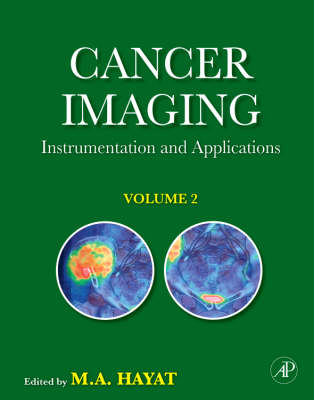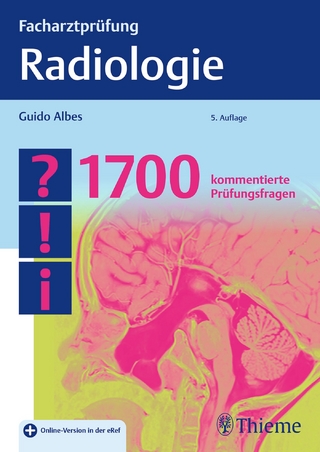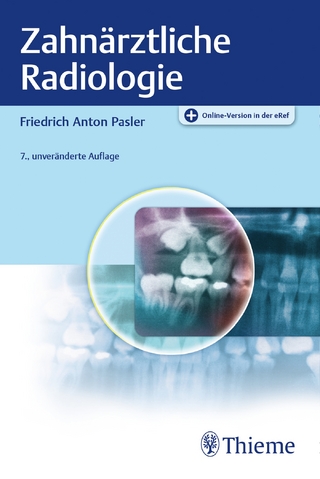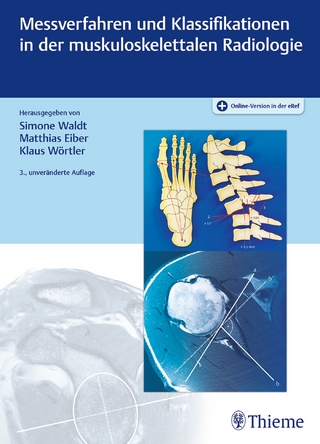
Cancer Imaging
Academic Press Inc (Verlag)
978-0-12-374183-7 (ISBN)
- Keine Verlagsinformationen verfügbar
- Artikel merken
This second of two volumes on Cancer Imaging covers the three major topics of imaging instrumentation, general imaging applications, and imaging of a number of human cancer types. Where the first volume emphasized lung and breast carcinomas, Volume 2 focuses on prostate, colorectal, ovarian, gastrointestinal, and bone cancers. Although cancer therapy is not the main subject of this series, the crucial role of imaging in selecting the type of therapy and its post-treatment assessment are discussed. The major emphasis in this volume is on cancer imaging; however, differentiation between benign tumors and malignant tumors is also discussed. This volume is sold individually, and Cancer Imaging, Volume 1 [ISBN: 978-0-12-370468-9] sells separately for $189 and also as part of a two volume set [ISBN: 978-0-12-374212-4] for $299.
Dr. Hayat has published extensively in the fields of microscopy, cytology, immunohistochemistry, immunocytochemistry, and antigen retrieval methods. He is Distinguished Professor, Department of Biological Sciences, Kean University, Union, New Jersey, USA.
Contents of Volume 1ContributorsPrefaceSelected GlossaryPart I: Instrumentation Chapter 1.1 Proton Computed Tomography Introduction Review of Prior Studies on Proton Imaging Image Formation Principles of Proton Computed Tomography Detector Design and Data Acquisition for Proton Computed Tomography Image Reconstruction Algorithms Discussion and Conclusions Acknowledgments References Chapter 1.2 Multidetector Computed Tomography Introduction Evolution of Computed Tomography Basic Physics of Multidetector Computed Tomography and Image Quality Artifacts in Multidetector Computed Tomography Radiation Dose Considerations Electrocardiogram-Gated Multidetector Computed Tomography Use of Intravenous Contrast in Multidetector Computed Tomography Oncologic Imaging Three-Dimensional and Multiplanar Reformations Three-Dimensional Volume Rendering Volumetric Analysis of Lesions Computer-Aided Detection References Chapter 1.3 Megavoltage Computed Tomography Imaging Introduction Fundamentals of Megavoltage Imaging Design and Performance Characteristics of Tomotherapy Megavoltage Computed Tomography Clinical Implementation of Megavoltage Computed Tomography Use of Megavoltage Computed Tomography for Daily Alignment: Head and Neck Cancers Adaptive Image Guidance: Lung Cancers Image-Based Volumetric Dose Calculations: Prostate Cancer Image-Based Volumetric Dose Calculations: Intracavitary Brachytherapy References Chapter 1.4 Integrated SET-3000G/X Positron Emission Tomography Scanner Introduction System Description Continuous Emission and Spiral Transmission Scanning PET/CT System with cEST Scanning Discussion References Chapter 1.5 High-Resolution Magic Angle Spinning Magnetic Resonance Spectroscopy Introduction Samples Spectral Analysis Results Discussion References Chapter 1.6 Spatial Dependency of Noise and Its Correlation among Various Imaging Modalities Introduction Impact of Noise in Images Noise Noise Variation Noise Correlation Autocorrelation Function Noise Correlation in Various Modalities Discussion References Chapter 1.7 Computed Tomography Scan Methods Account for Respiratory Motion in Lung Cancer Introduction Slow Scan Computed Tomography vs. Fast Scan Computed Tomography Four-Dimensional Computed Tomography Respiratory Gating Computed Tomography Volumetric Cine Computed Tomography Respiratory-Correlated Segment Computed Tomography References Chapter 1.8 Respiratory Motion Artifact Using Positron Emission Tomography/ Computed Tomography Introduction Origin of the Artifact Appearance of the Artifact Consequences of the Artifact Avoiding the Effects of the Artifact References Chapter 1.9 Gadolinium-Based Contrast Media Used in Magnetic Resonance Imaging: An Overview Introduction Mechanism of Action Classification Clinical Safety Other Applications References Chapter 1.10 Molecular Imaging of Cancer with Superparamagnetic Iron-Oxide Nanoparticles Introduction Iron Oxide Core and Superparamagnetism Synthesis and Coating Biocompatibility and Biodistribution Cell Tracking Organ-Specific/Passive Targeting Active Targeting Apoptosis Magnetic Relaxation Switches Imaging of Gene Expression High-Throughput Screening References Chapter 1.11 Adverse Reactions to Iodinated Contrast Media Introduction Acute General Adverse Reactions to Contrast Media Delayed General Adverse Reactions to Contrast Media Contrast Media-Induced Nephrotoxicity Contrast Media Interactions with Other Drugs and Clinical Tests Conclusion ReferencesPart II: General Imaging Applications Chapter 2.1 The Accuracy of Diagnostic Radiology Introduction Traditional Methods of Measuring Diagnostic Accuracy Signal Detection Theory Mammography Screening: Misses and False Alarms Mammography Screening: Radiologists and Pathologists Screening Mammography with Computer-Aided Detection (CAD) Conclusion References Chapter 2.2 Diffraction-Enhanced Imaging: Applications to Medicine Introduction Diffraction-Enhanced Imaging System Principles of Diffraction-Enhanced Imaging Diffraction-Enhanced Imaging Contrast Mechanisms Diffraction-Enhanced Imaging Contrast Mechanisms in Breast Cancer Specimens Diffraction-Enhanced Imaging Conventional Radiography: Comparison of Contrast Mechanisms in Breast Cancer Specimens References Chapter 2.3 Role of Imaging in Drug Development Introduction Drug Development Role of Imaging Technical Considerations Applications Discussion References Chapter 2.4 Characterization of Multiple Aspects of Tumor Physiology by Multitracer Positron Emission Tomography Introduction PET Tracers and Imaging Targets Complementary Value of Imaging Multiple Tracers Technical Challenges for Imaging Multiple Tracers The Future: Rapid Multitracer Positron Emission Tomography References Chapter 2.5 Whole-Body Magnetic Resonance Imaging in Patients with Metastases Introduction Methodology of Whole-Body Magnetic Resonance Imaging Clinical Results of Whole-Body MRI for Tumor Staging References Chapter 2.6 Whole-Body Imaging in Oncology: Positron Emission Tomography/Computed Tomography (PET/CT) Introduction Technical Considerations Clinical Considerations References Chapter 2.7 Whole-Body Cancer Imaging: Simple Image Fusion with Positron Emission Tomography/Computed Tomography Introduction Hardware and Software Fusion Fusion Technique for Cancer Imaging Advanced Fusion with Advanced Software References Chapter 2.8 Whole-Body Tumor Imaging: O-[11C] Methyl-L-Tyrosine/Positron Emission Tomography Introduction Development of O-[11C]Methyl-k-Tyrosine Whole-Body Tumor Imaging Using OMT Compared with FDG Brain Tumor Imaging Using OMT Compared with MET Conclusion References Chapter 2.9 Tumor Proliferation: 2-[11C]-Thymidine Positron Emission Tomography Introduction [11C]-Thymidine Positron Tomography Methodology Historical Development of Thymidine Positron Emission Tomography Validation Studies [11C]-MethyI-Thymidine 2-[11C]-Thymidine Validation of 2-[11C]-Thymidine Positron Emission Tomography in Patients Development and Application of Kinetic Models Kinetic Analysis of 2-[11C]-Thymidine Positron Emission Tomography Images Pharmacodynamic Studies Comparison of 2-[11C]-Thymidine with FDG-PET and Magnetic Resonance Imaging 2-[11C]-Thymidine PET to Detect Antitumor Activity in Clinical Drug Trials Discussion and Summary References Chapter 2.10 18F-Fluorodeoxyglucose Positron Emission Tomography in Oncology: Advantages and Limitations Introduction Mechanisms of 18FDG Uptake 18SFDG PET Uptake Patterns Advantages of 18FDG PET Limitations of 18FDG PET Clinical Indications Acknowledgments References Chapter 2.11 Positron Emission Tomography Imaging of Tumor Hypoxia and Angiogenesis: Imaging Biology and Guiding Therapy Introduction Hypoxia-Induced Changes in Tumor Behavior Hypoxia-Inducible Factor (HIF) Angiogenesis Tumor Hypoxia and Clinical Outcome: New Approach to an Old Problem The Importance of Identifying Hypoxia in Tumors Methods to Evaluate Tumor Hypoxia Polarographic Electrode Measurements of Tissue Oxygenation Evaluating Angiogenesis Positron Emission Tomography (PET) in Hypoxia Imaging Summary Acknowledgments References Chapter 2.12 Noninvasive Determination of Angiogenesis: Molecular Targets and Tracer Development Introduction Possible Targets for Imaging Angiogenesis Summary and Conclusion References Chapter 2.13 Gross Tumor Volume and Clinical Target Volume: Anatomical Computed Tomography and Functional FDG-PET Introduction Radioprotection of the Patient Method Discussion Problems and Their Solutions Expected Improvement References Chapter 2.14 Post-Treatment Changes in Tumor Microenvironment: Dynamic Contrast-Enhanced and Diffusion-Weighted Magnetic Resonance Imaging Introduction Contrast Media Acquisition of T1 Dynamic Contrast-Enhanced Data Dynamic Contrast-Enhanced-MRI in Experimental Oncology Dynamic Contrast-Enhanced-MRI in Clinical Oncology Limitations Conclusions and Perspectives Diffusion Magnetic Resonance Imaging References Chapter 2.15 In Vivo Molecular Imaging in Oncology: Principles of Reporter Gene Expression Imaging Introduction Reporter Gene Expression Imaging: A Subfield of Molecular Imaging Principles of Reporter Gene Expression Imaging Categories of Reporter Gene Expression Imaging Systems Principles of Optical Reporter Gene Imaging in Living Subjects Instrumentation and Techniques for Bioluminescence Imaging Future Outlook References Chapter 2.16 Medical Radiation-Induced Cancer Introduction Diagnostic Radiation Exposure Therapeutic Radiation Exposure Discussion ReferencesPart III: Applications to Specific Cancers Chapter 3.1 Adrenal Lesions: Role of Computed Tomography, Magnetic Resonance Imaging, 18F-Fluorodeoxyglucose-Positron Emission Tomography, and Positron Emission Tomography/Computed Tomography Introduction Computed Tomography Magnetic Resonance Imaging Positron Emission Tomography and Positron Emission Tomography/Computed Tomography Fine-Needle Aspiration (FNA) Biopsy Summary References Chapter 3.2 Hemangioendothelioma: Whole-Body Technetium-99m Red Blood Cell Imaging-Magnetic Resonance Imaging Introduction Histopathologic Classification Clinical Presentation and Radiology of Hemangioendothelioma Technetium-99m Red Blood Cell Imaging Summary References Chapter 3.3 Malignant Bone Involvement: Assessment Using Positron Emission Tomography/Computed Tomography Introduction SPECT and PET Imaging of Malignant Bone Involvement: Technological and Radiochemical Aspects Imaging of Bone Involvement in Common Human Malignancies References Chapter 3.4 Bone Metastasis: Single Photon Emission Computed Tomography/Computed Tomography Introduction Bone Metastasis Technical Aspects for Single Photon Emission Computed Tomography/Computed Tomography Clinical Applications for Single Photon Emission Computed Tomography/Computed Tomography Fusion References Chapter 3.5 Bone Cancer: Comparison of 18F-Fluorodeoxyglucose-Positron Emission Tomography with Single Photon Emission Computed Tomography Introduction What is 18F-Fluorodeoxyglucose-Positron Emission Tomography? What is Bone Single Photon Emission Computed Tomography? FDG-PET vs. Bone SPECT for Bone Metastases in Various Human Malignancies Summary References Chapter 3.6 Bone Metastasis in Endemic Nasopharyngeal Carcinoma: 18F-Fluorodeoxyglucose-Positron Emission Tomography Introduction Diagnosis and Staging Management Bone Metastasis References Chapter 3.7 Colorectal Polyps: Magnetic Resonance Colonography Colorectal Cancer Screening Virtual Colonoscopy Magnetic Resonance Colonography Future Directions References Chapter 3.8 Early Bile Duct Carcinoma: Ultrasound, Computed Tomography, Cholangiography, and Magnetic Resonance Cholangiography Introduction Pathology of Early Bile Duct Cancer Sonographic Features Computed Tomography Features Cholangiography and Magnetic Resonance Cholangiographic Features Cholangiographic Features Comparison between Pathology and Imaging References Chapter 3.9 Incidental Extracolonic Lesions: Computed Tomography Introduction Computed Tomography Colonography Technique Minimal Preparation Computed Tomography Technique Extracolonic Findings in Computed Tomography Colonography and Minimum Preparation Computed Tomography Comparison of Reported Studies Practical Implications and Handling of Extracolonic Findings in Specific Organs Conclusions References Chapter 3.10 Colorectal Cancer: Magnetic Resonance Imaging-Cellular and Molecular Imaging Introduction Magnetic Resonance Imaging: Basic Principles Magnetic Resonance Imaging of Colorectal Cancer in Clinical Use Imaging Strategies for the Future Conclusion References Chapter 3.11 Potential New Staging Perspectives in Colorectal Cancer: Whole-Body PET/ CT-Colonography Introduction Indications Patient Preparation and Imaging Procedure Image Evaluation Clinical Experience Perspectives and Considerations Possible Indications and Perspectives Limitations and Conclusion References Chapter 3.12 Thoracic Esophageal Cancer: Interstitial Magnetic Lymphography Using Superparamagnetic Iron Oxide Introduction Method Discussion Reference Chapter 3.13 Esophageal Cancer: Comparison of 18F-Fluoro-3-Deoxy-3-L-Fluorothymidine-Positron Emission Tomography with 18F-Fluorodeoxyglucose-Positron Emission Tomography Introduction Materials and Methods Results Discussion References Chapter 3.14 Gastrointestinal Stromal Tumors: Positron Emission Tomography and Contrast-Enhanced Helical Computed Tomography Introduction Imaging Techniques to Localize and Monitor Gastrointestinal Stromal Tumors Use of Imatinib in Treatment of Gastrointestinal Stromal Tumors 18F-Fluorodeoxyglucose Positron Emission Tomography Metabolic and Morphological Imaging References Chapter 3.15 Gastrointestinal Stromal Tumor: Computed Tomography Introduction Pathologic Features Clinical Features Computed Tomography Features Conclusion References Chapter 3.16 Gastrointestinal Lipomas: Computed Tomography Introduction Computed Tomography Other Imaging Methods References Chapter 3.17 Computed Tomography in Peritoneal Surface Malignancy Introduction Computed Tomography Diagnosis Computed Tomography Patient Selection Interpretive Computer Tomography Classification of the Small Bowel and Its Mesentery Acknowledgments References Chapter 3.18 Gastrointestinal Tumors: Computed Tomography/Endoscopic Ultrasonography Introduction Tumor Size Problems in Staging Classification Preoperative Three-Dimensional Structure and Volumetry of Gastrointestinal Tumors Future Prospects References Chapter 3.19 Magnetic Resonance Cholangiopancreatography Introduction Principles, Techniques, and Pitfalls Pancreas Biliary Tract References Chapter 3.20 Occult Primary Head and Neck Carcinoma: Role of Positron Emission Tomography Imaging Introduction Evaluation Positron Emission Tomography Panendoscopy Treatment Unknown Primary Adenocarcinoma Melanoma of Unknown Primary Tumor Cystic Metastatic Disease in the Neck Conclusions/Future Direction References Chapter 3.21 Benign and Malignant Nodes in the Neck: Magnetic Resonance Microimaging Introduction Technical Details Anatomy of the Lymph Node Metastatic Nodes Nodal Lymphomas and Infectious Lymphadenopathy Imaging Strategy for Diagnosing Lymphadenopathy in the Neck References Chapter 3.22 Oral Squamous Cell Carcinoma: Comparison of Computed Tomography with Magnetic Resonance Imaging Introduction Methods Results Discussion Conclusion References Chapter 3.23 Computed Tomography in Renal Cell Carcinoma Introduction Multidetector Computed Tomography Technique Staging of Renal Cell Carcinoma Role of Multidetector Computed Tomography in Conservative Treatment of Renal Cell Carcinoma Multidetector Computed Tomography of Cystic Renal Cell Carcinoma Multidetector Computed Tomography Features of Specific Subtypes of Renal Cell Carcinoma Differential Diagnosis of Renal Cell Carcinoma with Multidetector Computed Tomography Radiation Dose Associated with Multidetector Computed Tomography of Renal Cell Carcinoma References Chapter 3.24 Renal Cell Carcinoma Subtypes: Multislice Computed Tomography Introduction Renal Cell Carcinoma Subtypes Multislice Computerized Tomography Differentiation of RCC Subtypes by MDCT Discussion References Chapter 3.25 Renal Impairment: Comparison of Noncontrast Computed Tomography, Magnetic Resonance Urography, and Combined Abdominal Radiography/ Ultrasonography Introduction Combined Plain Abdominal Radiography and Ultrasonography Noncontrast Computed Tomography Magnetic Resonance Urography Materials and Methods Results Discussion and Conclusion References Chapter 3.26 Renal Lesions: Magnetic Resonance Diffusion-Weighted Imaging Introduction Technique Renal Diffusion Renal Normal Parenchyma References Chapter 3.27 Malignant Lymphoma: 18F-Fluorodeoxyglucose-Positron Emission Tomography Introduction Principle and Methods Positron Emission Tomography and Staging Positron Emission Tomography and Early Response to Therapy Post-Therapy Positron Emission Tomography Positron Emission Tomography before Transplantation Positron Emission Tomography and Radiotherapy and Radioimmunotherapy Positron Emission Tomography and Relapse References Chapter 3.28 Malignant Melanoma: Positron Emission Tomography Introduction Positron Emission Tracers Receptor-Specific PET Tracers Conclusion References Chapter 3.29 Multiple Myeloma: Scintigraphy Using Technetium-99m-2- Methoxyisobutylisonitrile Introduction Technetium-99m-MIBI Scintigraphy References Chapter 3.30 Nasopharyngeal Carcinoma: 18F-Fluorodeoxyglucose-Positron Emission Tomography Introduction Pretreatment Evaluation Post-Treatment Tumor Evaluation Response to Radiotherapy Response to Chemotherapy Residual or Recurrent Tumor Radiation-Induced Complications Conclusion References Chapter 3.31 Nasopharyngeal Carcinoma for Staging and Re-Staging with 18F-FDG-PET/CT Introduction Methods: Positron Emission Tomography/Computed Tomography Imaging Protocol Results and Discussion References Chapter 3.32 Ovarian Sex Cord-Stromal Tumors: Computed Tomography and Magnetic Resonance Imaging Introduction Granulosa Cell Tumors Fibroma, Fibrothecoma, and Thecoma Sclerosing Stromal Tumor of Ovary Sertoli-Leydig Cell Tumor Steroid Cell Tumor Summary References Chapter 3.33 Malignant Germ Cell Tumors: Computed Tomography and Magnetic Resonance Imaging Introduction Dermoid Cyst with Malignant Transformation Immature Teratoma Dysgerminoma Endodermal Sinus Tumor Choriocarcinoma Embryonal Carcinoma Malignant Mixed Germ Cell Tumors References Chapter 3.34 Ovarian Small Round Cell Tumors: Magnetic Resonance Imaging Introduction Imaging Findings References Chapter 3.35 Ovarian Borderline Serous Surface Papillary Tumor: Magnetic Resonance Imaging Introduction Discussion References Chapter 3.36 Chronic Pancreatitis versus Pancreatic Cancer: Positron Emission Tomography Introduction Usefulness of FDG-PET Limitations of FDG-PET Differential Diagnosis between Pancreatic Cancer and Inflammatory Pancreatic Lesions is There Any Better Tracer Than FDG? Conclusions and Future Perspective References Chapter 3.37 Pancreatic Cancer: p-[123l] Iodo-L-Phenylalanine Single Photon Emission Tomography for Tumor Imaging Introduction Materials and Methods Results Discussion Acknowledgments References Chapter 3.38 Pancreatic Islet Cell Tumors: Endoscopic Ultrasonography Introduction Classification of Islet Cell Tumors Detection and Localization by Endoscopic Ultrasonography Endoscopic Ultrasonographic Findings of Islet Cell Tumors Atypical Manifestations and Differential Diagnosis References Chapter 3.39 Parotid Gland Tumors: Advanced Imaging Technologies Introduction Dynamic Contrast-Enhanced Imaging Diffusion-Weighted Magnetic Resonance Imaging and Apparent Diffusion Coefficient Calculation Proton Magnetic Resonance Spectroscopy Imaging (1H-MRS) Positron Emission Tomography and Scintigraphy Benign Parotid Tumors Malignant Parotid Tumors References Chapter 3.40 Pituitary Macroadenomas: Intraoperative Magnetic Resonance Imaging and Endonasal Endoscopy Introduction Methods Results Discussion Future Directions References Chapter 3.41 Penile Cancer Staging: 18F-Fluorodeoxyglucose-Positron Emission Tomography/Computed Tomography Introduction Etiology, Histology, and Staging Therapy Diagnostics of the Primary Malignancy Lymph Node Metastases Scintigraphic Sentinel Lymph Node Biopsy Conventional Imaging Modalities for Staging of Penile Cancer PET and PET/CT for Staging of Penile Cancer Summary References Chapter 3.42 Malignant Peripheral Nerve Sheath Tumors: [18F] Fluorodeoxyglucose-Positron Emission Tomography Introduction Standard Diagnostic Procedures Treatment and Outcome Positron Emission Tomography Imaging in Malignant Peripheral Nerve Sheath Tumor Summary References Chapter 3.43 Prostate Cancer: 11C-Choline-Positron Emission Tomography Introduction Principle and Methods 11C-Choline PET for Intraprostatic Tumor Localization 11 C-Choline PET for Staging of Prostate Cancer 11C-Choline PET for Detection of Prostate Cancer Recurrence Acknowledgments References Chapter 3.44 Metabolic Characterization of Prostate Cancer: Magnetic Resonance Spectroscopy Introduction Magnetic Resonance Spectroscopy Current Techniques Current In Vivo Prostate Cancer Spectroscopy Future Directions Acknowledgment References Chapter 3.45 Prostate Cancer: Diffusion-Weighted Imaging Introduction Basics and Recent Advances of Diffusion-Weighted Imaging Current Problems and Future Directions of Diffusion-Weighted Imaging References Chapter 3.46 Prostatic Secretory Protein of 94 Amino Acids Gene-Directed Transgenic Prostate Cancer: Three-Dimensional Ultrasound Microimaging Introduction Brief Review of PSP94 PSP94 Gene-Directed Genetically Engineered Mouse Prostate Cancer Models Microimaging of GE-PC Mouse Models: Importance of Noninvasive Techniques PSP-TGMAP Microimaging Methods Results of PSP-TGMAP Imaging Studies Future Directions: Imaging of Prostate Tumor Vascularity References Chapter 3.47 Prostate Cancer within the Transition Zone: Gadolinium-Enhanced Magnetic Resonance Imaging Introduction Methods Results Discussion References Chapter 3.48 Rectal Wall Invasion of Locally Advanced Prostate Cancer: Comparison of Magnetic Resonance Imaging with Transrectal Ultrasound Introduction Selection of Patients for Radical Surgery Determining the Appropriate Surgical Procedure References Chapter 3.49 Local Staging of Prostate Cancer Using Endorectal Coil Magnetic Resonance Imaging Introduction Tumor Characteristics Grading and Partin Tables Prognostic Factors Staging of Prostate Cancer Imaging Techniques in Staging Endorectal Magnetic Resonance Imaging in Local Staging of Prostate Cancer Conclusion References Chapter 3.50 Extremity Sarcoma: Positron Emission Tomography Introduction Evolution of FDG-PET in Extremity Sarcoma Role of FDG-PET in the Differential Diagnosis of Connective Tissue Lesions Role of FDG-PET in Grading Soft Tissue Sarcoma Role of FDG-PET in Directing Biopsy Role of FDG-PET in Predicting Sarcoma-Specific Death Role of FDG-PET in Monitoring Response to Therapy Bone Sarcoma Role of FDG-PET in Evaluating Sarcoma Recurrence Future Directions References Chapter 3.51 Retroperitoneal Synovial Sarcoma: Color Doppler Ultrasound, Computed Tomography, and Magnetic Resonance Imaging Introduction Radiologic Findings C
| Erscheint lt. Verlag | 7.11.2007 |
|---|---|
| Verlagsort | San Diego |
| Sprache | englisch |
| Maße | 216 x 279 mm |
| Gewicht | 2570 g |
| Themenwelt | Medizin / Pharmazie ► Medizinische Fachgebiete ► Onkologie |
| Medizinische Fachgebiete ► Radiologie / Bildgebende Verfahren ► Radiologie | |
| ISBN-10 | 0-12-374183-1 / 0123741831 |
| ISBN-13 | 978-0-12-374183-7 / 9780123741837 |
| Zustand | Neuware |
| Haben Sie eine Frage zum Produkt? |
aus dem Bereich


